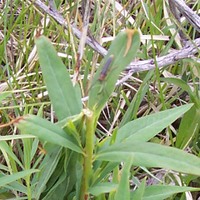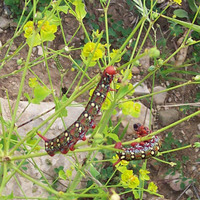Weed Control Efforts
Insects Can Be Your Friend
Gary Sager
Spring,
2009
Updated Summer, 2014
The size and terrain of our property makes it impractical to control
noxious weeds
by the most common methods:
hand removal,
mowing and spraying.
These methods are suitable for smaller properties
(perhaps up to 10 acres)
and for large properties consisting primarily of flat,
open meadows,
fields or pasture.
Our property is relatively large
(196 acres)
with about half being dense forest;
it has many slopes ranging from moderate to steep.
The size of the property suggests use of mechanized mowing and spraying,
but the terrain prohibits use of large machinery.
In fact,
some places are steep or dense enough to prohibit use of backpack
equipment.
An additional complication for us is a year-round stream running through
the property;
many of the most effective herbicides are not approved for use near
streams.
After some study,
we decided to enlist an
army
that would not be subject to these prohibitions.
In 2004,
2005 and 2006,
we purchased and released varieties of insects to attack three specific
noxious weeds:
Leafy Spurge,
Musk Thistle and Canada Thistle.
Results so far have been mixed,
ranging from
“excellent”
to
“time will tell”
and
“maybe not.”
The good news is that the most effective insects are likely to spread to
our neighbor's property over the years and help reduce weed problems for
them as well.
In fact,
some of the insects are now so widespread that they are no longer sold.
Those concerned that the insects might attack other plants should be
reassured that the insects are
selected and tested by the USDA
to be specific to the invasive species they attack before they are
allowed into the country.
Readers may want to follow links on the insects we describe below to see
if they are already present on their own property and consider obtaining
some if they are not.
When using insects for weed control,
an important part of the process is to regularly visit release sites and
identify what species have survived and are attacking the weeds
(see pictures below).
To facilitate this process,
we have marked the GPS coordinates of known sites and taken yearly
pictures of some of the worst infestatations.
Leafy Spurge
Leafy Spurge
is one of the hardest weeds to control because of its deep and extensive
root system.
New infestations
(less than three years old)
can be killed with herbicides or regular hand removal before their root
system is well developed.
Mowing is likely to speed up the spread unless properly timed.
Leafy Spurge has had a long presence on our property.
George Christie told us how his father had tried to control the
infestation on this property for many years using herbicides.
Thus,
we knew when we moved here the weed had been established for decades and
herbicides were having little or no effect.
(click on pictures to view larger version)

This gall caused by
Spurgia Esulae
inhibits seed production and weakens the spurge plant.
|

Oberea Erythrocephala
admiring her work
(note broken stem).
This insect lays an egg in the stem and the larvae eat the plant from
the inside.
|

Aphthona Nigriscutis
adults feed on leafy spurge foliage and flowers;
larvae feed on roots.
This insect and its sister flea beetles are the most promising insects for
spurge control.
|

We found this
caterpillar
in 2004.
This insect was released in Bridger Canyon decades ago,
but it does not thrive well enough to be a factor.
It is easily preyed upon by birds and mice.
|

Click beetle
found on spurge plant.
It must be lost since this beetle doesn't attack the plant.
A good eye and a good reference book are needed to properly identify
desirable insects!
|

Eggs laid by
Hyles Euphorbiae
(spurge hawkmoth)
on a spurge plant.
These will turn into caterpillars like the ones pictured at far left.
|
We released bugs to control Leafy Spurge at several sites in 2004 and 2005.
In 2007 and every year since,
we identified well established colonies of 3 of the 4 varieties we released.
There are additional varieties of insects released by others over the
years that have found their way to our area;
obviously,
those have had very limited success.

We located and marked 7 leafy spurge outbreaks on our property with a
GPS system.
We photograph two sites periodically to track the progress of spurge
spread or control.
We do not use any other controls
(e.g., herbicides)
on the photographed sites so we can judge the effectiveness of the
insects year to year.
The photo at right
(click to see a large version)
is a montage of pictures taken June 1st 2006 through 2009 at one of the
sites.
It seems to indicate that there is progress at this site.
Variations in weather from year to year make it difficult to judge;
2008 saw a very late Summer,
while 2009 saw very warm weather in May.
It may take 10 or more years to determine conclusively that our colonies
control the weed.
We stopped taking pictures at the other site in 2009
(after 4 years)
because few plants sprouted and the spurge no longer showed up in
photos.
There has been a marked decrease in the number of plants found at many
of the smaller infestations.
We have applied herbicides to several sites that appear to be relatively
new and less well established in hopes that we could retard their growth
and make them more susceptible to the insects that do manage to gain a
foothold over the next few years.
While spot spraying does seem to have reduced the density
(plants per square meter),
spurge can still spread through its deep and extensive root systems,
increasing the area affected.
Lately,
it appears the insects are getting the upper hand at these sites and we
have stopped spraying them.
Musk Thistle
We released
Trichosirocalus Horridus and Rhinocyllus Conicus
for
Musk Thistle.
The results have been dramatic.
We used to see Musk Thistle all along our driveway,
but now the plants are uncommon.
In Spring,
we can observe these insects in their mating frenzy on newly sprouted
plants;
we now leave these early plants to serve as incubators for a new
generation of bugs.
Trichosirocalus Horridus attacks the plant stem,
weakening the plant and causing it to sprout many weak stems.
Late in Summer,
we sometimes see what appears to be a patch of Musk Thistle only to find
it is a single plant reacting to Trichosirocalus Horridus attacks and in
such a weak state that it is unlikely to spread.
Rhinocyllus Conicus is especially satisfying,
since we can take people on hikes in early Summer,
spot a thistle,
break open the flower and show how larvae have eaten the seeds.
Rhinocyllus is now so widespread and successful that it is no longer
available for sale.
However,
they have a single generation per year and do not eat the seeds that
appear in late Summer.
We help things along by pulling the heads off thistles that put out late
flowers;
this is much easier than trying to pull up complete plants,
and probably just as effective.
Canada Thistle
Releases of
Urophora Cardui
and
Ceutorhynchus Litura
for
Canada Thistle
have produced less dramatic results;
the plant is difficult to control since it propagates through its root
system as well as by seeds,
so pulling up plants or collecting seed heads is only marginally
effective.
A well-timed mowing can help subdue this weed.
Pulling,
mowing and spraying helps weaken the "colony" of plants by reducing the
energy they can put into their root systems.
A combination of spot spraying and mowing has made an impact on a couple
of our sites,
but we are losing this battle in areas where mowing is impossible and
spraying is difficult.
We may resort to goats to clear those problem areas.
Bull Thistle
We have some problems with
Bull Thistle,
which does not appear to be attacked by the insects.
However,
the extent of infestation is small enough to control with spot spraying
and pulling.
Adventurous souls may want to try
eating it
themselves!
There are native thistle species,
so those who wish to allow the natives to continue on their property
need to do a detailed study of how to recognize the natives.
Hound's Tongue
A very annoying noxious weed we would like to control is
Hound's Tongue,
but there are no insects approved for release in the United States.
Insects have been approved and released in Canada,
and are starting to be found in northern Montana.
The reason these insects have not been certified for release in the
United States is that they have been observed to attack closely related
native species in southern states.
In large,
relatively flat and open spaces,
mowing and spraying can help control this plant,
but it grows well on the steep slopes and among the trees on our property
so we cannot use those techniques.
We take occasional hikes with a
backpack sprayer
along game trails to kill Hound's Tongue.
This is like the proverbial drop in the ocean,
but seeds spread primarily by attaching themselves to animal fur,
so game trails are prime areas to pick up and spread seeds.
Late in the Summer,
we collect the seeds of plants that have flowered and burn them.
It is good to pull up the entire plant,
but collecting only the seed stalk is still quite effective in
preventing a new generation of plants and is much easier to manage when
one has to collect plants by hand over a large area.
Plants can put out another seed stalk,
so timing is important.
Spotted Knapweed
We had a very small patch of spotted knapweed on the property,
but eradicated it with a combination of weed pulling and spot spraying
over the course of two years.
There are
insects specific to knapweed
we could have used if the problem had been extensive.
We are always on the lookout for this weed since there is an extensive
population elsewhere in Bridger Canyon.
Cheatgrass
Cheatgrass
is also a problem for us,
but we have not yet taken action beyond trying to plant some competitive
species in an attempt to keep it from completely taking over certain
areas.
Fertilizer is likely more effective than herbicide since the fertilizer
benefits competitive plants more than the cheat grass and herbicides that
kill cheat grass are very likely to kill competitors.
Prevention
Of course,
one should always opt for the ounce of prevention when possible.
In our case,
we made certain that topsoil was reserved and restored to construction
sites.
We reseeded disturbed areas as soon as possible.
We monitor them carefully and spot spray weeds as they make an
appearance.
As a result,
most disturbed areas are reasonably weed-free and there is little or no
need to continue spraying.
Similarly,
we reseed and monitor areas where logging has been done or slash has
been burned.
Conclusion
This posting has only touched the surface of what one should know about
weed control with insects.
One should follow the links above and do more research on the web to
learn more about the life cycles of the weeds and insects in order come
up with an effective plan.
Knowing the life cycles will help determine when to look for insects and
how to time the use of other measures
(mowing and herbicides)
so as not to interfere with them.
The Montana Department of Agriculture has a
web page
that is an excellent start.
The
Montana War on Weeds
web site is also a good source of information.






